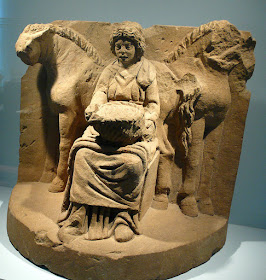 |
| Walking up to the summit of Loughcrew |
This
photo taken on the same day that I had the strange experience at
Loughcrew in County Meath, at Sliabh na Cailleach, which is the main hill at
the site. Sliabh na Cailleach is the abode of Béara, who is a Bean Sí (faerie woman) and
one of the Tuatha Dé Danann. There is a passage tomb on top, in which at the
equinox sunrise, the rays of the sun shine down and illuminate the inner
chamber. There are the graves of extremely ancient dead kings, queens,
and warriors there. The structure is 5,200 years old. It was old before the Egyptian pyramids were built.
 | |
| Mound at Loughcrew |
I give a full account of my strange and singular
experience at Loughcrew in my book Finding the McCains. The Celtic
faeries that are found in Ireland, Scotland, and the Isle of Man, are not your wee, cute type, of the Victorian era children's
books. They are tall, fair, powerful beings of light, and they are dangerous to be around. Béara is or has become in legend, a
primordial nature spirit and Queen of Winter. She can appear as an old
woman or as a beautiful young maiden, tall, fair, and dressed in green.
 |
| Béara as the Cailleach (veiled woman) |
Ultimately, Béara goes back to our distant past and she is linked to older lore. We must remember that our contemporary myths come to us through a dark mist of the distant past. It has been taboo to openly talk about our ancient European pre Christian faiths for many centuries. I think Béara is linked to not only the Tuatha Dé Danann, but to our very early Celtic roots... and back to the Indo European past. She has cognates and homologues in Ireland, the UK, and Europe, such as Epona and Frau Holle.
It is even quite possible that Béara is a form of the Gaelic Étain, associated with Sun, one of the Tuatha Dé Danann. Étain has another moniker, which is Eachraide, i.e. the Horse Rider, i.e Epona. She is a Celtic goddess associated with the Indo-European myth of the Horse and with fertility. The Horse in our early myths, and is a creation icon and a complex topic better left to another day.
 |
| Epona circa 250 AD Gaul |
The Glasistig is a type of Gaelic Faerie known also as a Maighean Uaine (green maiden). Her appearance is that of a tall, young, woman, with fair hair, blue eyes, and dressed in green. She is a tutelary faerie, a protectoress of cattle, of herders and shepherds, she watches over children as the father and mother go about their daily work... she is the protector of the household. The Glaistig in her tutelary form is certainly a homologue for older and more prominent beings, such as Béara. In our Gaelic lore, we often encounter cognates and conflated forms of the Tuatha Dé Danann of the Old Faith.
My current book that I am working on explores the world of the Faeries from the perspective of the Irish immigrants that settled in Colonial America in the early 1700s. What did they believe about the Faeries? Did they have concepts and beliefs that we recognise? Can we see in their tutelary spirits and their entities of wood, field and mountain, a glimpse of older gods? Let's find out...
© 2018 Barry R McCain

No comments:
Post a Comment